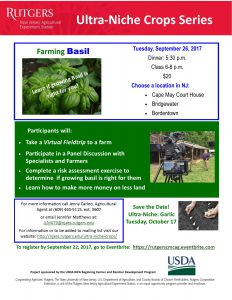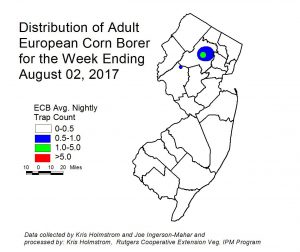‘Gloria’ is a large, yellow-fleshed, freestone, non-melting peach that ripens around mid-August. This late blooming variety, developed by Rutgers New Jersey Agricultural Experiment Station is unique because of its very attractive color, low acidity, distinctive flavor, and very firm flesh. Previously we saw that letting ‘Gloria’ hang longer lets fruit get sweeter and larger. Firm flesh allows for relatively longer hang time on the tree after fruit has reached commercial maturity, providing greater flexibility in harvest scheduling and shipping to growers as well as buyers. We have estimated how long it is safe to let ‘Gloria’ fruit remain on the tree and in cold storage without affecting fruit quality. Studies in two orchards in Southern NJ indicated that; [Read more…]
Archives for August 2017
Basil: Upcoming Ultra-Niche Crops Series Workshop
 Rutgers Cooperative Extension is continuing its Ultra-Niche Crop Series with the upcoming workshop “Farming Basil.” This workshop, the fifth class in the Ultra-Niche educational series for farmers seeking new crop opportunities, will be held on Tuesday, September 26, 2017 from 5:30 to 8 p.m., simultaneously in Cape May Court House, Bordentown and Bridgewater, New Jersey.
Rutgers Cooperative Extension is continuing its Ultra-Niche Crop Series with the upcoming workshop “Farming Basil.” This workshop, the fifth class in the Ultra-Niche educational series for farmers seeking new crop opportunities, will be held on Tuesday, September 26, 2017 from 5:30 to 8 p.m., simultaneously in Cape May Court House, Bordentown and Bridgewater, New Jersey.
Ultra-Niche Crops are defined as exceptionally high-value crops that can provide a significant source of income to the farmer while using a minimal amount of land. In this session, farmers will learn how to grow, market and sell basil [Read more…]
Veg IPM Update: Week Ending 8/02/17
Sweet Corn
 European corn borer (ECB) catches remain low, but are occurring in some locations with greater intensity (see ECB map at left). This is the early part of the second flight. In recent years, this flight has been very sporadic. ECB feeding in NJ sweet corn plantings is still nearly non-existent at this time, but should appear again within a week, although it may be obscured by fall armyworm (FAW) feeding. Check 5 plants each in 10 random locations for a 50 plant sample. Look for “shot-hole” injury, and consider treating when the number of infested (from ECB or FAW) plants in a 50 plant sample exceeds 12%. As infested plants proceed to the pre-tassel stage, live larvae and damage may be found in the emerging tassels. Once plants hit full tassel, ECB larvae will move downward on the stalk and re-enter the plant near the area where ears are forming. This can result in direct injury to the ear. Growers should consider an insecticide application at the full tassel stage to target ECB larvae as they migrate downward. This application can eliminate larvae that have escaped any earlier insecticide applications. [Read more…]
European corn borer (ECB) catches remain low, but are occurring in some locations with greater intensity (see ECB map at left). This is the early part of the second flight. In recent years, this flight has been very sporadic. ECB feeding in NJ sweet corn plantings is still nearly non-existent at this time, but should appear again within a week, although it may be obscured by fall armyworm (FAW) feeding. Check 5 plants each in 10 random locations for a 50 plant sample. Look for “shot-hole” injury, and consider treating when the number of infested (from ECB or FAW) plants in a 50 plant sample exceeds 12%. As infested plants proceed to the pre-tassel stage, live larvae and damage may be found in the emerging tassels. Once plants hit full tassel, ECB larvae will move downward on the stalk and re-enter the plant near the area where ears are forming. This can result in direct injury to the ear. Growers should consider an insecticide application at the full tassel stage to target ECB larvae as they migrate downward. This application can eliminate larvae that have escaped any earlier insecticide applications. [Read more…]
Potato | Tomato Disease Forecast 8-2-17
Click to View | Download Report 8-2-17
We will be tracking DSVs for Late blight development and calculating P-days for initiating the first early blight fungicide application.
The first late blight fungicide application is recommended once 18 DSVs accumulate from green row. Green row typically occurs around the first week in May in southern NJ. An early season application of a protectant fungicide such as mancozeb (Dithane, Manzate, Penncozeb) or Bravo (chlorothalonil) as soon as the field is accessible is suggested. Please be vigilant and keep a lookout for suspect late blight infections on young plants. No late blight has been reported in our region to date.
Remember the threshold for P-days is 300! Once 300 P-days is reached for your location, early blight fungicide applications should be initiated. Growers who are interested in using this model should choose the location above that is closest in proximity to their farming operation and should regularly check the Cornell NEWA website (http://newa.cornell.edu) where this information is compiled from. Click on Pests Forecasts from the menu, select your weather station, and click on tomato diseases, set accumulation start date, and a table of daily and total DSVs will be generated.
Disease severity values (DSVs) for early blight, septoria leaf spot, and tomato anthracnose development are determined daily based on leaf wetness (due to rainfall, dew) and air temperature.
On a daily basis DSV values can range from 0 to 4 where 0 = no chance for disease development to 4 = high chance for disease development. DSVs are accumulated during the production season.
Fungicide applications are based on an individually determined DSV threshold. The first fungicide application for the control of these three diseases is not warranted until 35 DSVs have accumulated from your transplanting date. After that, growers can base fungicide applications on different DSV thresholds.
Reports generated by Ryan Tirrell
Rutgers, The State University of New Jersey
